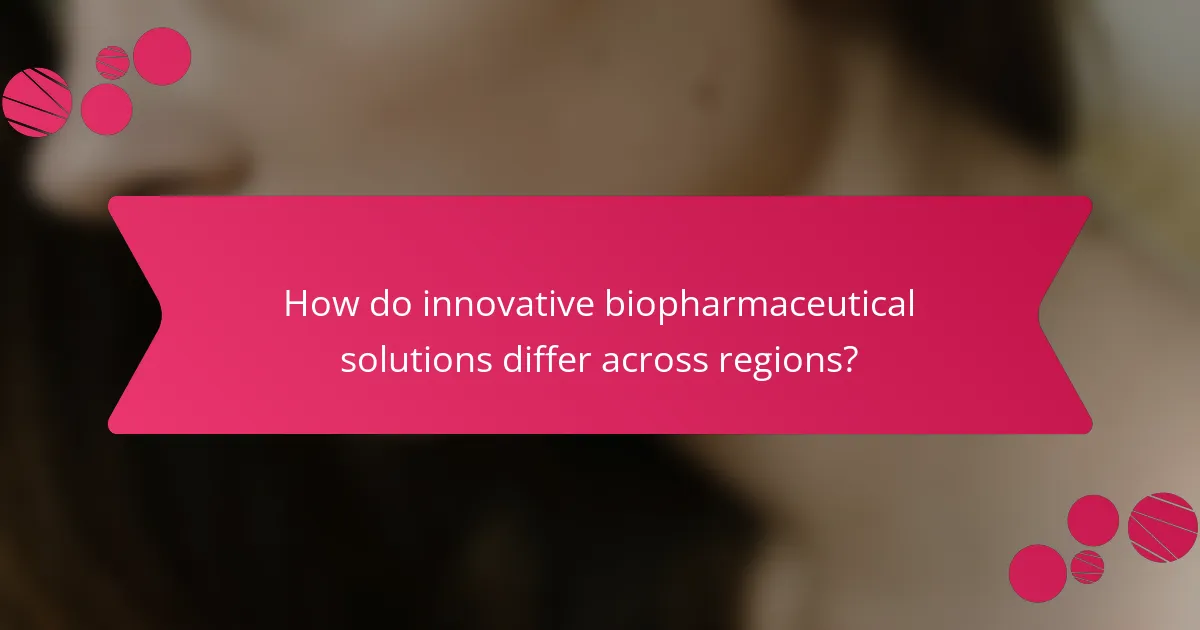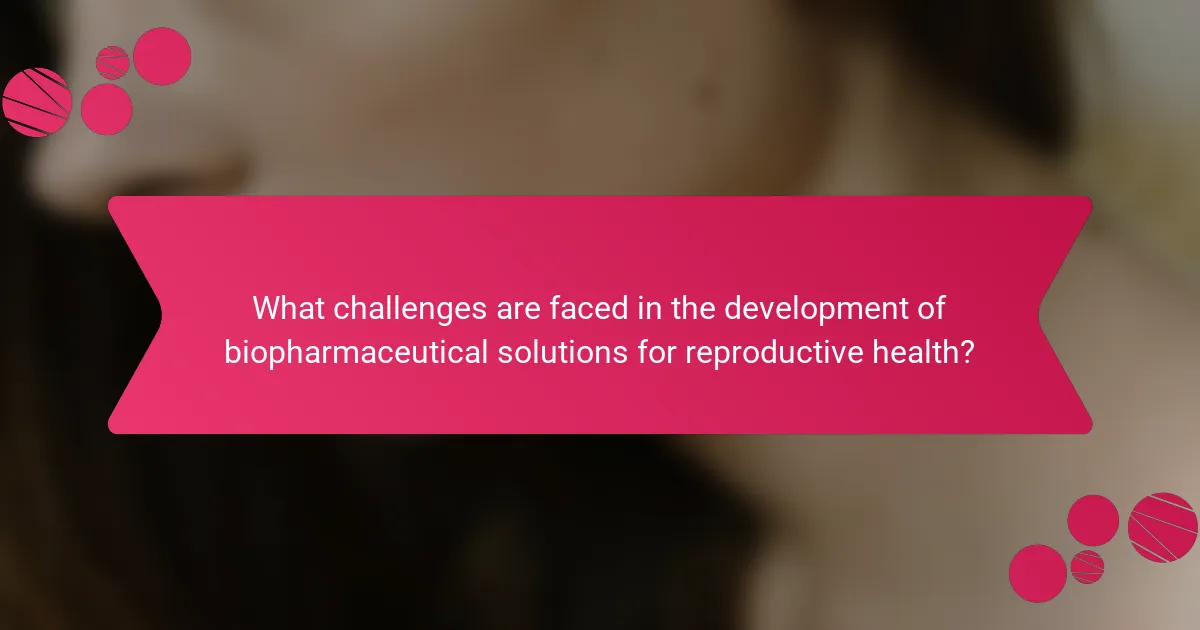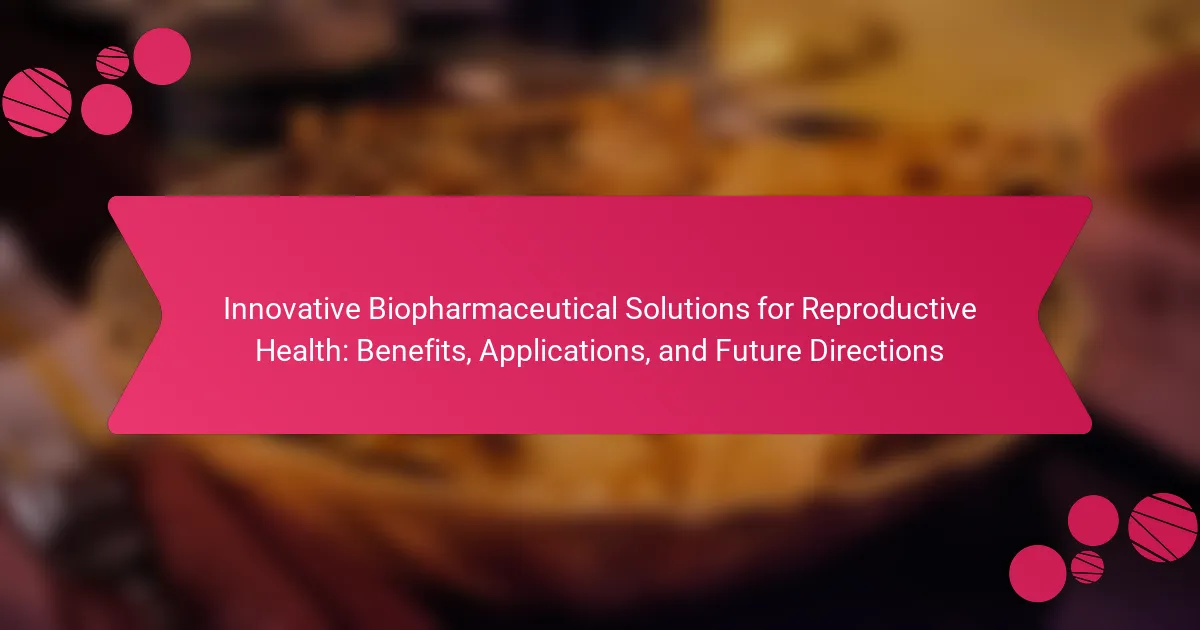Innovative biopharmaceutical solutions significantly improve reproductive health by offering targeted treatments and personalised medicine. They enhance fertility treatments, improve hormonal therapies, and address genetic disorders. Future advancements may include gene editing and artificial intelligence integration. Regional adaptability is crucial for meeting diverse healthcare needs and overcoming regulatory challenges.

What are the key benefits of innovative biopharmaceutical solutions for reproductive health?
Innovative biopharmaceutical solutions significantly enhance reproductive health by providing targeted treatments, improving outcomes, and expanding options. These solutions offer benefits such as increased efficacy in managing conditions like infertility, reduced side effects compared to traditional therapies, and personalised medicine approaches that cater to individual patient needs. As a result, patients experience better quality of life and higher success rates in reproductive interventions. Future directions include the integration of advanced technologies, such as gene editing and regenerative medicine, which promise to further revolutionise reproductive health care.
How do these solutions improve fertility outcomes?
Innovative biopharmaceutical solutions significantly enhance fertility outcomes by targeting specific reproductive health challenges. These solutions improve hormonal balance, optimise ovarian function, and increase embryo viability. For example, advancements in hormone therapies can regulate menstrual cycles and improve ovulation rates. As a result, these treatments contribute to higher pregnancy rates and overall reproductive success.
What role do they play in managing reproductive disorders?
Innovative biopharmaceutical solutions play a critical role in managing reproductive disorders by targeting hormonal imbalances and enhancing fertility. These therapies can improve ovulation, regulate menstrual cycles, and support reproductive health. Recent advancements include personalised medicine approaches that tailor treatments to individual genetic profiles, increasing efficacy and minimising side effects. As a result, patients experience improved outcomes and better quality of life.
Which patient demographics benefit the most from these advancements?
Women of reproductive age, particularly those with infertility issues, benefit most from advancements in biopharmaceutical solutions for reproductive health. These innovations address hormonal imbalances, enhance ovulation, and improve pregnancy outcomes. Additionally, patients with specific genetic conditions may find tailored treatments that significantly increase their chances of conception. Emerging therapies also support older women, who often face greater challenges in reproductive health.

What applications do innovative biopharmaceutical solutions have in reproductive health?
Innovative biopharmaceutical solutions play a crucial role in reproductive health by enhancing fertility treatments, improving hormonal therapies, and addressing genetic disorders. These applications include advanced in vitro fertilisation techniques, targeted therapies for polycystic ovary syndrome, and gene editing technologies for hereditary conditions. As a result, patients experience higher success rates and personalised care. Future directions involve integrating artificial intelligence to optimise treatment protocols and improve patient outcomes.
How are these solutions integrated into assisted reproductive technologies?
Innovative biopharmaceutical solutions are integrated into assisted reproductive technologies by enhancing success rates and improving patient outcomes. These solutions include hormone therapies, genetic screening tools, and advanced cell culture media. They optimise ovarian stimulation, support embryo development, and reduce miscarriage rates. As a result, patients benefit from personalised treatment plans tailored to their unique reproductive health needs.
What therapeutic areas are being targeted with these innovations?
Innovative biopharmaceutical solutions are targeting several therapeutic areas in reproductive health, including infertility, hormonal disorders, and contraceptive technologies. These innovations aim to enhance treatment efficacy and patient outcomes. For example, advancements in gene therapy are being explored to address genetic causes of infertility. Additionally, novel hormonal therapies are being developed to regulate menstrual cycles and manage conditions like polycystic ovary syndrome (PCOS). As a result, these innovations are shaping the future of reproductive health by providing more personalised and effective treatment options.
Which biopharmaceuticals are currently leading in reproductive health applications?
Leading biopharmaceuticals in reproductive health applications include hormone therapies, fertility medications, and gene therapies. These innovations enhance reproductive outcomes and address various conditions such as infertility and hormonal imbalances.
1. Hormone therapies: Regulate menstrual cycles and manage menopause symptoms.
2. Fertility medications: Stimulate ovulation and improve chances of conception.
3. Gene therapies: Target genetic disorders affecting reproduction.
As a result, these solutions are reshaping reproductive health by providing effective treatments and improving patient experiences.

How do innovative biopharmaceutical solutions differ across regions?
Innovative biopharmaceutical solutions for reproductive health vary significantly across regions due to differences in regulatory environments, healthcare infrastructure, and cultural attitudes. For instance, North America often leads in research and development, offering advanced therapies and technologies. In contrast, regions like Africa may focus on more accessible and affordable treatment options due to economic constraints.
Regulatory frameworks influence the speed of innovation. The U.S. Food and Drug Administration (FDA) can expedite approvals through programs like Breakthrough Therapy Designation, while other regions may have more stringent processes. Additionally, cultural perceptions of reproductive health can shape the acceptance and use of biopharmaceuticals, affecting market penetration.
As a result, innovative solutions must be tailored to meet local needs, balancing cutting-edge advancements with practical applications. This regional adaptability is crucial for the future of reproductive health solutions.
What regional variations exist in the adoption of these solutions?
Regional variations in the adoption of innovative biopharmaceutical solutions for reproductive health are significant. North America leads in research and development, driven by advanced healthcare infrastructure. Europe follows, focusing on regulatory compliance and patient access. In Asia, rapid growth is observed, influenced by increasing fertility awareness and investment in healthcare technologies. Latin America shows a growing interest, though challenges remain in accessibility and affordability. Africa faces barriers such as limited resources but is seeing emerging solutions tailored to local needs. These differences reflect unique healthcare landscapes and cultural attitudes towards reproductive health.
How do cultural attitudes influence the acceptance of reproductive health innovations?
Cultural attitudes significantly impact the acceptance of reproductive health innovations. Societal beliefs and values shape perceptions about biopharmaceutical solutions, influencing their adoption. For example, communities with progressive views on reproductive rights may embrace innovations more readily than those with conservative perspectives.
Education plays a crucial role in shaping these attitudes. Informed populations are more likely to recognise the benefits of innovative solutions, such as enhanced safety and efficacy in reproductive health. Conversely, misinformation can lead to skepticism and resistance, hindering acceptance.
Cultural norms surrounding gender roles and family planning further influence acceptance. In cultures where traditional roles prevail, there may be resistance to innovations that empower individual reproductive choices. Engaging community leaders and tailoring communication strategies can foster a more favourable environment for innovation acceptance.
Overall, understanding cultural attitudes is essential for successfully introducing biopharmaceutical solutions in reproductive health. Addressing these factors can enhance outreach efforts and improve health outcomes.

What are the unique attributes of specific innovative biopharmaceutical products?
Innovative biopharmaceutical products for reproductive health possess unique attributes that enhance their effectiveness. These products often feature targeted delivery systems, which improve bioavailability and reduce side effects. Additionally, they may utilise advanced biotechnological methods, such as monoclonal antibodies or gene therapies, offering personalised treatment options. Their formulation may include novel excipients that stabilise active ingredients, ensuring longer shelf life and efficacy. Furthermore, some products demonstrate unique mechanisms of action, providing alternatives for patients who do not respond to conventional therapies.
How do personalised medicine approaches enhance reproductive health solutions?
Personalised medicine approaches significantly enhance reproductive health solutions by tailoring treatments to individual genetic profiles. This customisation leads to improved efficacy and reduced side effects. For example, advanced genetic screening can identify specific fertility issues, allowing for targeted therapies that increase the chances of successful conception. Additionally, personalised medicine can optimise hormonal treatments, ensuring that patients receive the most effective dosage based on their unique biological responses. As a result, these approaches foster better overall reproductive health outcomes and pave the way for innovative biopharmaceutical advancements in the field.
What differentiates these products from traditional reproductive health treatments?
Innovative biopharmaceutical solutions differ from traditional reproductive health treatments by offering targeted therapies and personalised approaches. These solutions utilise advanced technologies to address specific reproductive issues, enhancing effectiveness and minimising side effects. For example, they may incorporate gene editing or stem cell therapy, which are not present in conventional methods. Additionally, these innovations often provide faster results and improved patient outcomes, making them a compelling alternative.

What challenges are faced in the development of biopharmaceutical solutions for reproductive health?
The development of biopharmaceutical solutions for reproductive health faces significant challenges. These include regulatory hurdles, high research and development costs, and complex biological mechanisms. Additionally, ensuring patient safety and efficacy remains a critical concern. Collaboration among stakeholders is essential to address these obstacles effectively.
Which regulatory hurdles impact innovation in this field?
Regulatory hurdles significantly impact innovation in biopharmaceutical solutions for reproductive health. Key challenges include lengthy approval processes, stringent safety regulations, and varying international compliance standards. These obstacles can delay product availability and increase development costs. Additionally, the need for extensive clinical trials can limit the pace of innovation. Addressing these regulatory barriers is essential for fostering advancements in reproductive health solutions.
What are the common misconceptions about biopharmaceutical treatments?
Common misconceptions about biopharmaceutical treatments include the belief that they are exclusively for severe diseases and that they lack regulatory oversight. Many think these treatments are too expensive and ineffective compared to traditional therapies. Additionally, some assume that all biopharmaceuticals are the same, overlooking the unique attributes of specific products. Misunderstandings about the safety and side effects of these treatments also persist, as patients may fear adverse reactions without recognising the rigorous testing involved.

What future directions are anticipated for biopharmaceutical solutions in reproductive health?
Innovative biopharmaceutical solutions in reproductive health are expected to focus on personalised treatments and advanced gene therapies. These approaches aim to enhance fertility outcomes and address genetic disorders. Emerging technologies like CRISPR and stem cell therapy may revolutionise reproductive health by offering targeted interventions. Additionally, increased collaboration between biotech firms and healthcare providers will drive innovation and accessibility in reproductive health solutions.
How is technology shaping the next generation of reproductive health solutions?
Technology is revolutionising reproductive health solutions through innovative biopharmaceutical advancements. These solutions enhance fertility treatments, improve hormonal therapies, and offer personalised medicine approaches. For example, gene editing technologies can correct genetic disorders affecting reproduction. Additionally, telemedicine platforms provide accessible consultations, increasing patient engagement. Future directions include integrating artificial intelligence for predictive analytics in reproductive health, ensuring tailored treatment plans. These advancements not only improve outcomes but also empower individuals with more control over their reproductive choices.
What emerging trends should stakeholders be aware of in 2025?
Stakeholders in reproductive health should focus on personalised medicine, digital health integration, and regenerative therapies in 2025. Personalised medicine tailors treatments to individual genetic profiles, enhancing efficacy. Digital health integration utilises telemedicine and health apps, improving access and patient engagement. Regenerative therapies, including stem cell applications, show promise in restoring reproductive functions. These trends reflect a shift towards more targeted, accessible, and innovative solutions in biopharmaceuticals.
What role will patient-centered approaches play in future developments?
Patient-centered approaches will significantly enhance future developments in innovative biopharmaceutical solutions for reproductive health. These approaches prioritise individual patient needs, leading to tailored treatments and improved outcomes. By integrating patient feedback, biopharmaceutical companies can refine their therapies, ensuring they address specific concerns such as side effects and efficacy. This focus fosters greater patient engagement and adherence, ultimately driving advancements in reproductive health solutions. As a result, the industry can expect more personalised and effective interventions that align with patient values and preferences.
What best practices should be followed when considering innovative biopharmaceutical solutions?
To consider innovative biopharmaceutical solutions effectively, follow these best practices: prioritise patient-centric research, invest in collaborative partnerships, and leverage advanced technologies. Ensure compliance with regulatory standards and focus on sustainable development. Continuously assess market needs to align solutions with reproductive health challenges.
